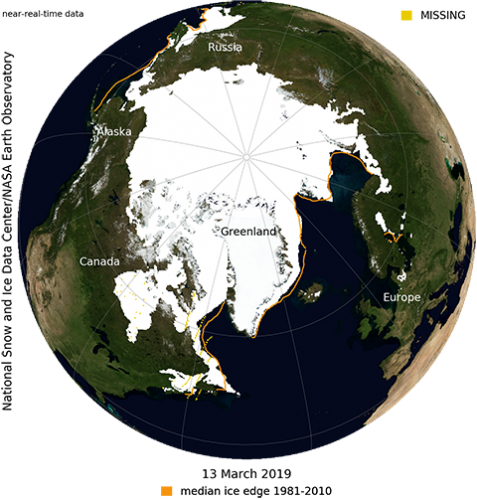Arctic sea ice at maximum extent for 2019
Arctic sea ice likely reached its maximum extent for the year, at 14.78 million square kilometers (5.71 million square miles) on March 13, 2019, according to scientists at the National Snow and Ice Data Center (NSIDC) at the University of Colorado Boulder. The 2019 maximum is effectively tied with the 2007 maximum at seventh lowest in the 40-year satellite record.

This NASA Blue Marble image shows Arctic sea ice on March 13, 2019, when sea ice reached its maximum extent for the year. Sea ice extent for March 13 averaged 14.78 million square kilometers (5.71 million square miles), the seventh-lowest in the satellite record, tied with 2007.
“While this is not a record low year for the Arctic sea ice maximum extent, the last four years have been the lowest in our record, reflecting a downward trend in winter sea ice extent,” said NSIDC senior research scientist Walt Meier. “This is just another indicator of the rapid changes that are occurring in the Arctic due to climate change.”
Please note that the Arctic sea ice extent number is preliminary—continued winter conditions could still push the ice extent higher. NSIDC will issue a formal announcement at the beginning of April with full analysis of the possible causes behind this year’s ice conditions, interesting aspects of the ice growth season and graphics comparing this year to the long-term record. For example, this year has been marked by particularly low extent in the Bering Sea, including substantial ice loss during the month of February.
Sourc: National Snow & Ice Data Center
- 331 reads
Human Rights
Fostering a More Humane World: The 28th Eurasian Economic Summi

Conscience, Hope, and Action: Keys to Global Peace and Sustainability

Ringing FOWPAL’s Peace Bell for the World:Nobel Peace Prize Laureates’ Visions and Actions

Protecting the World’s Cultural Diversity for a Sustainable Future

Puppet Show I International Friendship Day 2020

